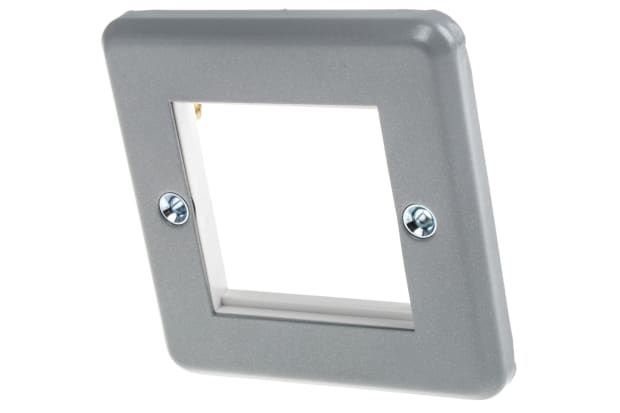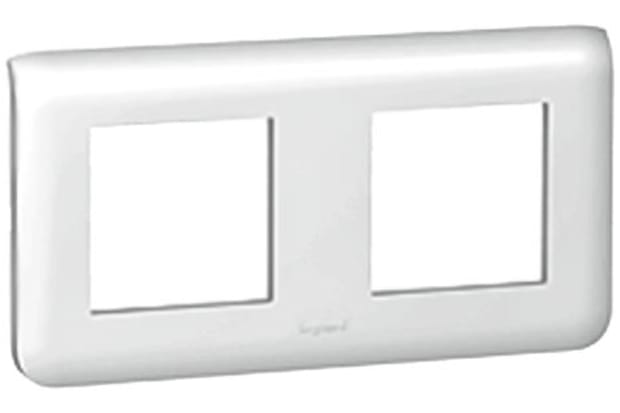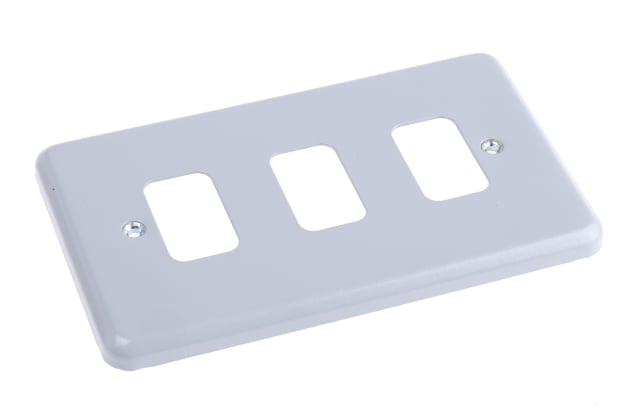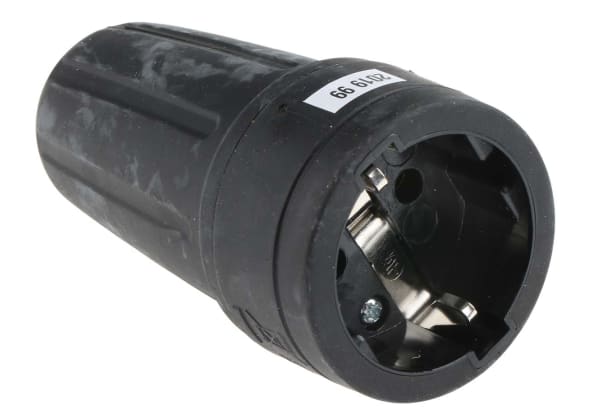- Published 24 Jan 2023
- Last Modified 29 Aug 2023
- 7 min
A Complete Guide to Faceplates
Our guide will help you understand faceplates, the different types and finishes, and what ‘number of gangs’ means.

What is a Faceplate?
Electrical faceplates are covers secured over socket back boxes, switches, and other electrical wiring outlets. They are widely used at almost all domestic and industrial cable entry points. They conceal wired connections, improving safety and giving a cleaner look.
Faceplates are often referred to as wall plates or mounting plates and are sold alongside other electrical installation accessories. The most common places you will see them are over wall sockets or light switches in homes and workplaces. The vast majority are made from either plastic or metal and are designed to screw, clip or push (snap-fit) into place.
This introductory guide will cover the basics of how to choose and buy wall plates or electrical socket covers online. To answer the question ‘what is a faceplate?’ more fully, we will look at:
- The various types sold online in the UK and elsewhere
- The wide range of available options for faceplate materials and finishes
- What it means to choose a wall plate by ‘number of gangs’
Faceplate Types
There are many different kinds of electrical faceplates and mounting plates on offer today. Most are cheap to buy and simple to install.
Individual unit cost is dictated by multiple factors, including:
- Model type
- Intended function
- Materials used
- Overall build quality
- Number of gangs required
For specialised uses, you can also pay more for various configurations of custom faceplates and combination wall plates.
In addition to the core connection types, there are several popular styles of faceplate mounting available online. This allows users to decide how and where the finished installation will sit. Common options include:
Choosing the best electrical wall plates for a given application is partly a matter of taste, preference and budget. However, you will have to know which basic faceplate type you need for covering a specific sort of connection point.
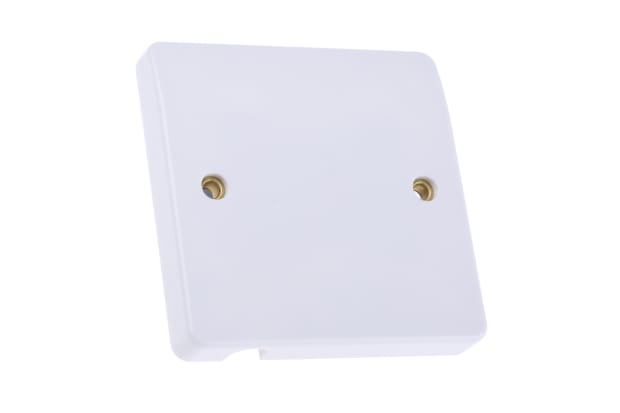
Flex Outlet Plate
Although the term ‘flex outlet’ is sometimes used as a generic term, it technically denotes a specific type of mounting plate. Electricians will normally use a flex outlet plate to cover a single cable entry point. For this reason, you’ll often see them sold as cable outlet sockets, cable faceplates, or similar.
A true flex outlet plate usually has a single round hole in its centre. Some models may feature entry holes offset higher or lower, or concealed in the bottom edge of the plate. They are most often found under worktops, units and cabinets, providing a cable entry point for fixed appliances.
Most will have four screw-in connector terminals on the reverse side, along with a cable clamp and an earth connection. They are usually limited to 20A of electrical current. You will have to make sure that the entry hole is of a suitable size for the cable or wire you want to pass through it.
Brush Faceplate
Rather than fixed hole(s), a brush faceplate features two sets of brushes for cabling to pass through from the socket backbox. They are most often used for low-voltage wiring of devices and appliances like HDTVs, stereo systems, soundbars, and speakers.
The main advantage of a brush faceplate is that they avoid the need to fully terminate cables at the wall. Instead, the brushes neatly conceal a more rough-cut hole where the backbox sits. They allow various sorts of cables and wires - power, HDMI cable, audio, SCART, coaxial - to pass through, holding them loosely but tidily.
This is handy for electrical devices you might want to move around from time to time, or don't want to anchor with a fixed termination at the wall. As well as making installation far quicker and easier, fewer connections mean reduced potential for signal loss, interference or instability.
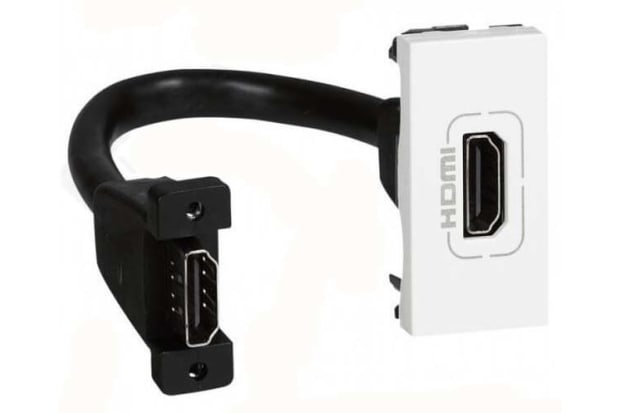
HDMI Faceplate
An HDMI faceplate is ideal for wiring a high definition digital A/V signal through from a wall outlet or source device (computers, projectors) to an audiovisual device. They provide an HDMI connector or socket for cables to enter directly, with no need for an A/V adaptor or converter.
Network Faceplate
A network faceplate gives a direct entry/exit point for communications, usually via phones or wired internet access. Telephone sockets are where an external BT phone line comes into your home or office. They are known as NTE5 sockets and accept RJ11 telephone jacks.
Ethernet connectors or RJ45 sockets are also widely found in homes and offices. They allow for increased bandwidth connections, with higher upload/download speeds than most Wi-Fi. These types of broadband socket covers are usually located close to routers and desktop PCs. They provide a direct termination at the wall outlet for various network and communication cables, including Cat5e, Cat 6 and 6a, and Cat7.
You might also see products listed as a ‘keystone faceplate’ when buying network socket covers online. This means they have a female data connector or keystone jack mounted directly into them. Again, this will often be an RJ11 or RJ45 socket. They are used for setting up LANs (Local Area Networks), linking multiple devices like modems, computers, phones, fax machines, and optical displays.
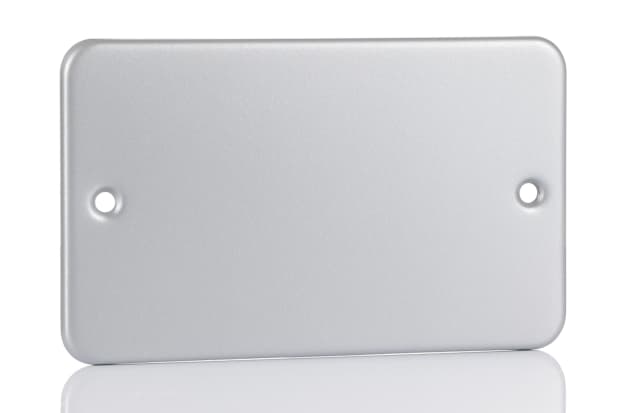
Electrical Blanking Plate
An electrical blanking plate is used to cover a socket or outlet that doesn’t need access for cable entry. It has no holes or termination points in the face. Instead, it provides a smooth and shallow protective cover that sits reasonably flush with the wall.
They are helpful when a socket is no longer in use, or where all necessary wiring is entirely contained within the backbox, and no external connection is needed. If the outlet is no longer in use, a blanking plate improves safety and prevents dust, dirt or moisture from entering an exposed socket.
They are also popular as a handy workaround, avoiding the need to fill, plaster and repaint over an old outlet. Circular blanking plates are available for covering specific types of switches and sockets.
Wall Plates for Light Switches
Wall plates for light switches function just the same way as any other type of socket covers. On the back, you will find added features that allow the connection of many common switch types.
Light switch cover plates in the UK are sold in a variety of flexible options. Popular searches include faceplates for rocker switches, push-button switches and dimmer switches.
What Does ‘Number of Gangs' Mean?
When choosing an electrical wall plate for covering outlets or switches, you will need to know how many ‘gangs’ are required at your connection point.
Simply put, this just means the number of switches or sockets on that particular plate. Single gang faceplates have just one switch or input connection. 2-gang means there are two, 4-gang means there are four, and so on.
In the UK, 2-gang socket covers (including blanking plates) will be wider than a single or 1-gang, since our plugs don’t tend to stack vertically. In some cases, 2-gang or 3-gang light switch covers may be the same size as a single gang unit, but with multiple rocker or dimmer switches instead of one.
Faceplate Finishes
The finish on a wall plate refers to both the faceplate material used and the general presentation style of the product. Nearly all consumer brands and models will be made from either plastic or metal. The basic function of the unit will be much the same either way.
Plastic faceplates are almost always the cheapest online, with metal versions tending to be a little more expensive. Nearly all plastic cover plates are offered in white, and sometimes in black or grey.
Many people prefer a metal option for a more sophisticated look in homes and offices. Metal equivalents come in a much broader range of tints, shades and textures. Popular choices for faceplate finishes include large plastic blanking plates (matte or polished/gloss), die-cast zinc, chrome faceplates, and brushed stainless steel faceplates.
Related Guides
Related links
- Audio & Video Faceplates
- Faceplates & Mounting Plates
- Siemens Aluminium 1 Gang Face Plate Thermoplastic Outlet Plate
- Fused Spurs Buying Guide
- A Guide to Rocker Switches
- Siemens White 1 Gang Face Plate Thermoplastic Outlet Plate
- Siemens Off White 1 Gang Face Plate Thermoplastic Outlet Plate
- Siemens Silver 1 Gang Face Plate Thermoplastic Outlet Plate
